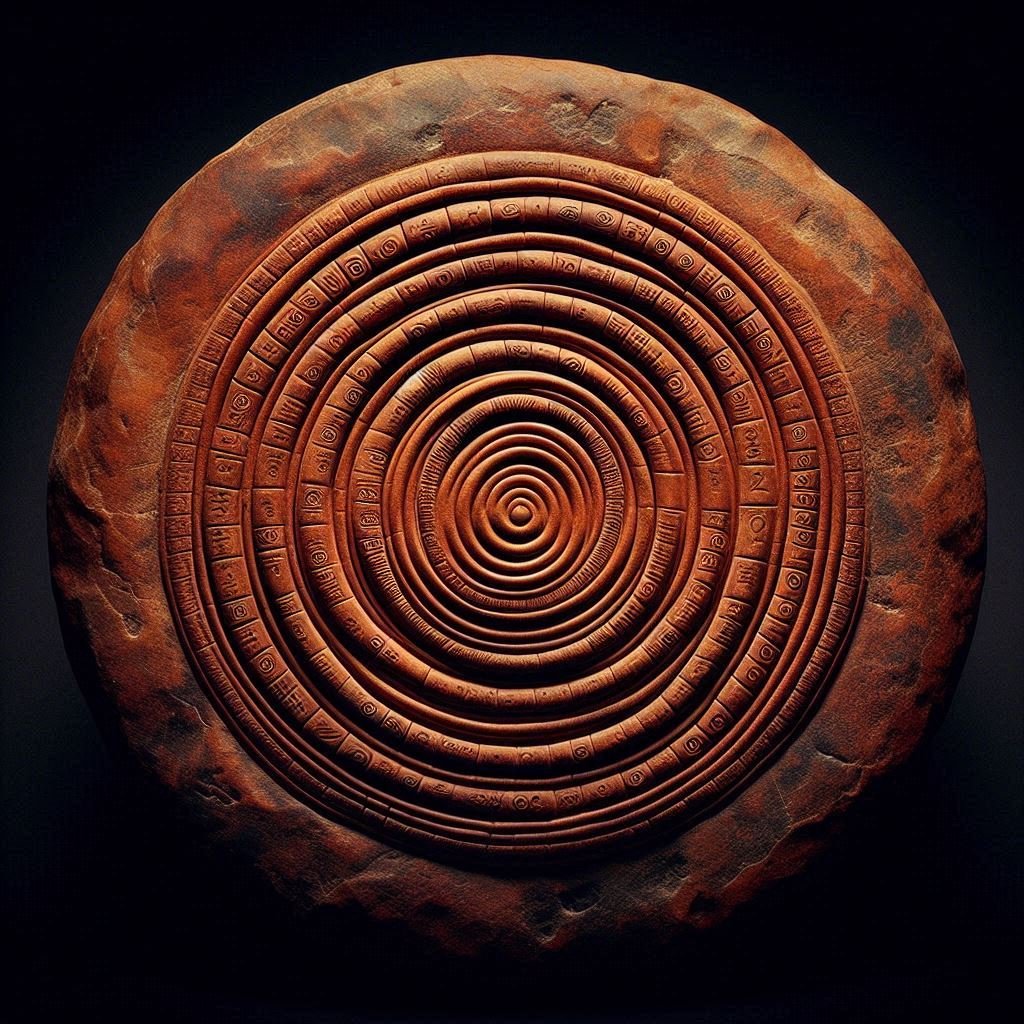Listen to “Phaistos Disc” on Spreaker.
It was a hot summer day in 1908 on the island of Crete, Greece, when archaeologist Luigi Pernier carefully brushed away layers of dust and soil in the ruins of an ancient Minoan palace at Phaistos. The excavation site had already yielded a treasure trove of artifacts—pottery, tools, and wall frescoes—but nothing prepared him for what lay in his hands that day.
In the midst of the debris, he discovered a small, round clay disc, perfectly preserved despite being thousands of years old. What made it extraordinary wasn’t its size—it was only about six inches across—but the markings pressed into its surface. These symbols were unlike anything Pernier or anyone else had ever seen. Spiraling from the edge to the center, each side of the disc was covered with 241 mysterious signs.
Some depicted humans, others animals, and some seemed to be objects that defied easy identification. The symbols were stamped, not scratched, suggesting that whoever made the disc had used movable type—an astonishingly advanced technique for the Bronze Age. The disc had been made somewhere around 1700 BCE, more than 3,700 years ago. And yet, its purpose remained a complete mystery.
From the moment it was unearthed, the Phaistos Disc became one of the most tantalizing enigmas in archaeology—a riddle that has resisted every attempt at solving.
A Message Lost in Time
The Phaistos Disc is more than just an artifact; it’s a message from the past, a whisper from a civilization that left almost no written records. Unlike the monumental inscriptions found in Egypt or Mesopotamia, the Minoans left very little in the way of writing, and even less that we can confidently understand.
Scholars have tried to decode the symbols for over a century. Some suggest it is a form of writing, others believe it may be a game, a calendar, or even a prayer. The disc was discovered in a palace complex, which adds to the mystery—was it used by royalty, priests, or scribes? And why would such an artifact be pressed with what appears to be an early form of movable type?
One thing is clear: whoever created it intended for the disc to communicate something. But what? And to whom?
An Impossible Script
The disc contains 45 unique signs arranged in 61 groups, or “words.” But no other artifact exists with the same script. This makes it extremely difficult to compare, to analyze, or to find patterns. Most ancient languages are cracked because researchers can compare multiple texts. Hieroglyphics, for example, were unlocked thanks to the Rosetta Stone, which provided the same message in both Greek and Egyptian symbols. But the Phaistos Disc stands alone.
Attempts to decipher it often lead down strange and conflicting paths. Some researchers believe it is a religious hymn. Others claim it could be a record of trade, a magical charm, or even a birth announcement. Each theory attracts supporters and critics. The debate has grown heated over the years, and new interpretations continue to appear, but none are universally accepted.
Some of the more outlandish theories suggest it could be an ancient map, a musical score, or even a coded message from a lost civilization. Yet every approach runs into the same problem: without a key, the symbols refuse to yield their secrets.
The Mystery Deepens
Over time, the disc has been examined by countless scholars, cryptographers, and enthusiasts. High-resolution photographs, 3D scans, and even computer algorithms have been applied to try and find meaning. Patterns emerge and disappear. Some argue the signs are purely decorative, a kind of ancient art, rather than a form of writing. Others are convinced there is a language hidden in plain sight, a code waiting to be cracked.
Adding to the intrigue is the context in which it was found. Phaistos was a center of Minoan civilization, famous for its palaces, trade networks, and artistic achievements. The Minoans were technologically advanced for their time, building complex plumbing systems, massive fortifications, and intricate pottery. The disc’s precision—symbols stamped in clay rather than painted—suggests the use of a technique that would not be common for thousands of years.
Could it be evidence that the Minoans had developed printing technology long before Gutenberg? Some scholars think so, but there’s no definitive proof. The idea that a Bronze Age civilization could invent movable type centuries before it became commonplace in Europe is mind-blowing and adds another layer to the mystery.
A Puzzle That Transcends Time
Every attempt at translation brings new controversies. Over the decades, linguists have proposed dozens of interpretations. Some claim it is written in a form of ancient Greek or an early Minoan language called Linear A. Others suggest it could be a proto-Alphabetic system, a stepping stone toward modern writing.
The challenge is compounded by the lack of additional examples. One disc, and nothing else like it. No Rosetta Stone, no bilingual texts, nothing to confirm a theory. Some researchers have even used modern computer science techniques—pattern recognition, frequency analysis, and AI algorithms—to try and make sense of the symbols. They find patterns, but the meaning remains elusive.
This has led to one of the strangest aspects of the disc: it is both ancient and futuristic. Its symbols suggest a civilization capable of complexity and abstraction, yet the object itself is completely alien to us, a relic that feels like a puzzle sent across time.
Theories That Captivate and Confound
One theory claims the disc is a religious artifact. The spiral pattern, some argue, represents the journey of the soul, a ceremonial hymn, or an invocation to the gods. Another theory suggests it is a calendar, tracking lunar or agricultural cycles. Some even propose that it is a board game, where each symbol represents a move or action.
Cryptographers, especially amateur sleuths, have offered more radical ideas. Could the disc contain secret instructions for some advanced Minoan technology? Could it be a coded message intended to be understood only by initiates of a secret society? Theories run wild, from the plausible to the fantastical.
Despite all these attempts, one fact remains: the Phaistos Disc resists explanation. It is a puzzle designed to frustrate, to tease, and to remind us how much of the past is lost.
Why We Can’t Stop Wondering
What makes the Phaistos Disc so compelling is not just its age or beauty, but its mystery. It is a link to a civilization that disappeared without a trace, a message we cannot fully comprehend. It invites us to imagine the hands that pressed its symbols, the minds that conceived its meaning, and the world in which it was created.
Perhaps the greatest fascination lies in its very unknowability. Unlike other historical artifacts, the Phaistos Disc doesn’t give answers. It gives questions. Who made it? Why did they create it? What does it say? And most chillingly: was it meant for us to understand at all?
The disc challenges assumptions about human history and intelligence. It hints at sophistication that seems almost impossible for its time. It reminds us that history is not always linear, that knowledge can appear and vanish, leaving only tantalizing clues behind.
The Human Obsession with Codes
There is something inherently human about wanting to crack a code, to make sense of a mystery. For over a century, scholars and amateurs alike have stared at the Phaistos Disc, imagining what it could mean. Some see themselves as detectives in a cosmic game of hide-and-seek, trying to communicate with someone who lived thousands of years ago.
And maybe that’s part of the disc’s magic. It connects us across millennia, bridging the gap between us and a civilization long gone. The thrill is not only in the possibility of understanding, but in the act of trying. Every failed attempt, every disputed theory, every new insight keeps the mystery alive.
The disc forces us to confront a humbling truth: some puzzles may never be solved. And yet, that doesn’t stop us from trying.
A Modern Mystery
Today, the Phaistos Disc sits in the Heraklion Archaeological Museum in Crete, behind glass, protected from the world. Tourists and scholars gaze at it, marveling at its spiraling symbols, wondering if it holds the key to secrets we are not ready to understand. High-resolution images and digital reconstructions allow researchers to study it without touching it, but the mystery remains intact.
Every year, new theories emerge. Every year, enthusiasts create digital simulations, decoding experiments, and even artistic interpretations. Some claim they have solved it, but no solution has ever gained wide acceptance. It is a puzzle that evolves with each generation, a secret that refuses to die.
The disc’s allure lies not just in its enigma, but in the possibilities it represents. Could it contain lost knowledge of the Minoan world? Or is it simply an artifact of ritual or art, a reflection of human creativity? We may never know, but the fascination endures.
The Enduring Legacy of the Phaistos Disc
The Phaistos Disc is more than an archaeological find; it is a story, a mystery, and a challenge. It reminds us that history is not always written in words we can read. Sometimes it is written in symbols, in gestures, in objects that defy our understanding.
It also reminds us of the human desire to connect—to reach across time, to touch the minds of those who lived thousands of years before us. Every attempt to decode the disc, every theory, every speculation, is a small bridge between our world and theirs.
And maybe that’s why the Phaistos Disc continues to captivate us. Because it is a riddle, yes—but also a mirror. It reflects our curiosity, our obsession with the unknown, and our willingness to chase mysteries even when the odds of solving them are impossibly small.
The Phaistos Disc will remain a puzzle for the foreseeable future, but in that very uncertainty lies its power. It is an artifact that dares us to ask questions, to imagine, and to dream. And for that reason, it is, perhaps, one of the most human objects ever discovered.




